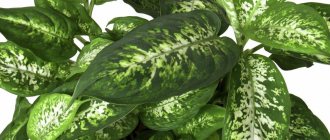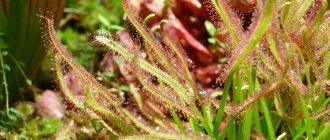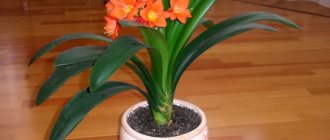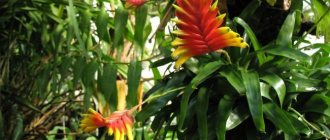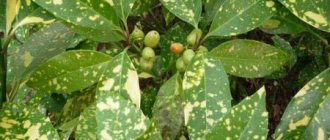Flower growers are “domesticating” more and more new exotic plants that attract attention with their decorativeness and unusualness, adding comfort and originality to the interior. Succulents are especially popular (not least because of their modest size and unusual appearance), standing out even in the largest collection of indoor plants. These include pedilanthus, which from a distance can easily be mistaken for an artificial flower - its shiny, smooth leaves seem to be made of plastic. The features of caring for it at home will be discussed further.
Transfer
Frequently replanting pedilanthus is not recommended. The procedure is carried out in the spring only when the roots completely fill the entire volume of the pot. The flower grows best in a cramped container. The diameter of the new pot should be 2-3 cm larger than the previous one.
After transplanting, it is better to shade the pedilanthus a little . This will help him settle in faster.
Since pedilanthus has a wide and overgrown root system, it does not need to be completely freed from the old soil during replanting, since this can injure the root system.
Before transplanting, it is recommended to carefully examine the roots . If there are damaged or rotten ones, they should be carefully cut with a sharp knife or blade, and the sections should be sprinkled with crushed activated carbon. This procedure should be carried out with gloves, since the sap of the plant is poisonous and can cause burns.
The soil
The soil for pedilanthus should be light, well permeable to moisture and air. If you buy soil in a store, then a substrate for succulents and cacti will be suitable .
To prepare the soil yourself, you should mix turf, leaf soil and sand in a ratio of 3:2:3. Before planting, it should be disinfected by keeping it in a water bath for 10-15 minutes.
Pedilanthus needs a pot with drainage holes and a good layer of drainage consisting of foam, clay shards or pebbles.
Description of the species and varieties
Pedilanthus is an original beauty plant from the Euphorbiaceae family. Its natural habitat is North, Central and South America. The genus includes 15 varieties, which differ greatly from each other, depending on where they grow. Among them you can find small trees, shrubs and even succulents that do not have leaves.
On a fleshy gray-green stem, as a rule, there are ovate or pointed leaves with short petioles or sessile. The leaf color is green or white-green. In most species, the foliage has a light waxy coating, which indicates the plant’s adaptability to hot conditions. The stem has a stepped or zigzag shape. This is explained by the fact that with each new leaf the direction of the stem changes.
Small flowers are collected in umbrella-shaped inflorescences . Red or pink bracts, shaped like a shoe or a bird, make the flowering of pedilanthus especially original and unforgettable.
The main types grown indoors:
- Pedilanthus titimaloides is a shrub, up to 80 cm high. The stems are curved and fleshy. The color of the lanceolate leaves differs depending on the variety - they can be green with a white, pink or cream border. The inflorescences are red.
- Pedilanthus Finca - has zigzag glossy stems and bright green leaves. The inflorescences are red.
- Pedilanthus spur is a tree-type species that grows up to 2-3 meters in height. It has dark green stems and rounded, pointed edges, slightly wavy leaves.
Pedilanthus macrofruited is a succulent that does not have leaves. The fleshy gray-green stems are excellent for storing water.
Pedilanthus titimaloidum - care and propagation of indoor plants
The indoor flower pedilanthus titimaloid with a lush crown and decorative leaves of elegant color looks like an artificial composition. Its leaves and small flowers with bright bracts are covered with a waxy coating and therefore seem too smooth and shiny, as if made of plastic. Flower growers love a persistent and hardy plant called Pedilanthus titimaloides for its unpretentious nature, as well as its exotic appearance. It is very easy to care for, but you need to know some nuances.
Pedilanthus: general description of the plant
The species Pedilanthus titimaloides belongs to the genus Pedilanthus, which is included in the Euphorbiaceae family.
When cut, it produces a milky juice that irritates the mucous membranes and skin. That is why all manipulations with the plant must be carried out with gloves, and also placed in places inaccessible to children and pets.
Pedilanthus titimaloidum - a spectacular and unpretentious houseplant
Attention! The poisonous juice of pedilanthus has antimicrobial properties and is used in medicine in drug formulations.
Pedilanthus is an evergreen perennial with long dark green or grayish cylindrical stems and pointed leaves 10 cm long and 3 cm wide. Depending on the variety and type, the leaves are oval or elongated, with smooth or wavy edges, green, light green and olive in color. With age, the stems lose their decorative properties, their lower part becomes bare.
In their natural environment, pedilanthus are found in North, Central and South America. And the appearance of the plant depends on its proximity to the equator.
- In arid areas, the plant has a thickened, water-storing stem with virtually no leaves.
- In warm and humid tropical forests, pedilanthus grow as shrubs or small trees with dense foliage and showy flowers. This tree can reach 3 meters in height.
The average size of indoor specimens is 60-80 cm, but pedilanthus can stretch up to 1.5 meters, if conditions permit. An adult specimen has elastic stems, so the plant can be grown without additional support.
The small pink flowers of pedilanthus are shaped like pointed shoes, so the plant received a beautiful name, derived from the Greek words “shoe” and “flower”.
For reference! The flower is also called the “Devil’s Backbone” or “Jacob’s Ladder”, because when new leaves appear, the trunk bends like “steps”.
Varieties of indoor plants
About 15 species of the genus Pedilanthus are found in nature. Only a few varieties are grown in indoor floriculture, which will be discussed below.
Pedilanthus macrocarpus
An evergreen bush with straight stems directed straight up. The stems are thick, fleshy, with little branching, round or flat in shape, pale green or grayish in color. They are covered with a waxy substance.
There are no leaves. Instead, small scaly growths are located along the entire length of the stems. During the flowering period, pedilanthus large-fruited resembles a candle in appearance: straight, bare stems are crowned with red or orange lancet buds.
The shape of the flowers is typical of all pedilanthus: they are tiny glossy “shoes”. Pedilanthus largefruited is native to the arid Mexican deserts. Thanks to its succulent properties, it is able to accumulate moisture and easily tolerate short-term dryness.
Some varieties of pedilanthus have completely green leaves.
Pedilanthus tithymaloides
In indoor floriculture this is the most common type. It is unpretentious, does not require special care, reproduces well, and thanks to the interesting color of the leaves and the zigzag shape of the stems, it has high decorative properties.
At home, pedilanthus titimaloides is grown as a bush. It is reluctant to branch, so to achieve decorativeness, 3-5 plants are planted in a pot.
The leaves are shiny, elongated, with a pointed tip, and are basically green.
For reference! Variegated varieties of pedilanthus have a white, cream or pinkish border on the leaf blades. With proper care, small red “shoe” inflorescences appear on the tops of the stems in late autumn.
Pedilanthus finkii
The stems are zigzag-shaped, long, strong and elastic, bare along the entire length. Finki's pedilanthus leaves are present only at the tops of the stems. The color of the leaf blades of most varieties is green, with a uniform color. The shape is pointed, elongated with a characteristic waxy coating.
Attention! Many have not even seen pedilanthus bloom, because it is extremely difficult to achieve this at home. To stimulate flowering, the temperature in the room in winter should be 14-18 degrees, which is practically impossible at home.
Temperature
In spring and summer, the optimal temperature for pedilanthus is 20-26 degrees. It can withstand temperatures up to 30 degrees for a short time, but only if the room is frequently ventilated.
Pedilanthus is afraid of sudden changes in temperature and drafts, so when ventilating it is better to move it away from the window.
In winter, the plant feels most comfortable at 14-18 degrees: such conditions ensure abundant flowering. Too high a temperature causes the stem to stretch and leaves to fall off.
Titimaloid pedilanthus: home care
The flower is light-loving, so it should be kept on the windowsill of southern, south-eastern and south-western windows. For variegated varieties, the level of lighting is especially important, since with a lack of light, variegated leaves lose their decorative effect.
However, the plant can get burned from too aggressive sunlight. Therefore, in the spring-summer period, a flower located on the southern windowsill is shaded or moved deeper into the room during the midday hours.
The optimal temperature for growing is 20-25 degrees in summer and 14-16 degrees in winter. The plant is afraid of drafts, but loves fresh air, so in summer it is recommended to take it out of the house into the garden or onto the balcony, and in winter to ventilate the room, protecting the flower from cold air.
The flower requires a slightly acidic or neutral soil mixture, loose, light in structure, which can be purchased at the store (soil for succulents) or prepared independently from turf and leaf soil with the addition of river sand in equal proportions. When using soil taken from a garden bed, it must first be disinfected (calcined in the oven or frozen outside).
To achieve looseness and prevent stagnation of water in the earthen coma, perlite, vermiculite, and charcoal are added to the soil mixture.
Variegated varieties are especially beautiful
Attention! Pedilanthus titimaloides reacts to all negative conditions by shedding its foliage.
He is equally afraid of drying out the earthen clod and overflowing with moisture. When the soil becomes acidic, the weak root system rots and the plant risks dying. When it gets too dry, in order to save energy to maintain life, it sheds its foliage, which grows back when favorable conditions are restored.
In summer, abundant regular watering with soft, warm, settled or filtered water at room temperature is necessary. In winter, watering is reduced to a minimum (once every 1-2 weeks). Water for irrigation can be slightly heated. The frequency depends on the location of the flower and the surrounding humidity. The plant can hardly tolerate dry air, so in winter it is recommended to periodically spray it or place a container with wet expanded clay next to the pot.
It is better to choose the watering schedule for your pedilanthus yourself, focusing on the moisture state of the substrate - in the summer the soil should be slightly moist, and in the winter the upper layers of the soil should have time to dry out.
Pedilanthus titimaloides reacts positively to water procedures, including bathing in the shower and wiping the leaf blades. After washing, the leaves become brighter and the plant begins to grow. Water procedures can be arranged all year round, but in the summer, as a rule, more often - at least once a month.
Attention! If the tap water is too hard and there is no flow-through filter, it is better to avoid rinsing the pedilanthus in the shower. Instead, it is recommended to wipe the leaves from the top and bottom with a damp soft cloth.
Slow growth, overly elongated stems, unhealthy foliage and lack of flowering indicate a lack of nutrients. In this case, it is recommended to feed the plant.
Fertilizers for Pedilanthus titimaloides
Home care involves applying fertilizers. To do this, use fertilizers with a minimum proportion of nitrogen and the required content:
- iron (takes part in metabolic processes);
- phosphorus (necessary for the absorption of mineral supplements);
- calcium (needed to strengthen cellular structure, to normalize phosphorus and nitrogen metabolism).
Typically, fertilizing is carried out with complex liquid mineral fertilizers for indoor plants and succulents from spring to autumn once a month.
Pedilanthus does not need a big pot
Pruning and replanting
Pedilanthus titimaloides branches reluctantly and, if not pruned at all, the elongated stems will do just fine without lateral shoots. To stimulate the branching process, pruning should be done regularly.
Attention! To make the pedilanthus bush spreading and voluminous, it is recommended to root 3-5 cuttings in one pot.
Replant rarely, as the root system grows in the spring before active growth begins. As soon as the plant's roots have entwined the drainage holes of the pot, it is time to replant.
Due to the undeveloped root system, deep pots are not recommended for pedilanthus. When replanting, it is necessary to select a pot 2-3 cm larger than the previous one.
If desired, you can update the top layer of soil in the pot by removing and adding the required amount of soil.
LiveInternetLiveInternet
—Categories
- ORTHODOXY (14)
- HANDMADE (14)
- beads (1)
- BUSINESS, FINANCE (0)
- IN THE WORLD OF ANIMALS (0)
- EVERYTHING FOR CHILDREN (2)
- EMBROIDERY (1)
- KNITTING (359)
- compilations (333)
- crochet (8)
- for women (4)
- for men (2)
- master classes (2)
- patterns (2)
- children (1)
- FOR THE COTTAGE AND GARDEN (206)
- BEAUTY and HEALTH (90)
- diets, weight loss (27)
- good for health (23)
- face masks (1)
- traditional medicine (35)
- hair care (5)
- foot care (1)
- COOKING (4030)
- collections of recipes (499)
- pies, pies (255)
- poultry dishes (232)
- for dessert (221)
- baked goods (130)
- pancakes, pancakes (115)
- main courses (113)
- minced meat (107)
- jam (97)
- sauces, dressings, marinades (78)
- vegetable dishes (73)
- cottage cheese dishes (59)
- for breakfast (58)
- from offal (57)
- for Easter (55)
- Lenten dishes (47)
- dough (45)
- side dish (42)
- pasta and cereals (31)
- pizza (29)
- culinary tricks (25)
- recipes with lavash (24)
- egg dishes (19)
- sausages, dishes with sausages (14)
- fast food (10)
- for multicooker (8)
- cheeses (2)
- fish dishes (155)
- dishes with mushrooms (44)
- winter preparations (222)
- snacks (235)
- casseroles (74)
- potato dishes (125)
- porridge (28)
- shrimp, squid, seafood (23)
- meat dishes (156)
- drinks (100)
- food decoration (1)
- salads (231)
- sweet pastries (38)
- soups (196)
- cakes (107)
- HOLIDAYS (34)
- New Year (12)
- Christmas (9)
- Easter (7)
- Valentine's Day (2)
- February 23 (1)
- March 8 (1)
- MISCELLANEOUS UTILITIES (18)
- SPORTS (2)
- COMFORT IN THE HOUSE (180)
- indoor plants (176)
- SEWING (1)
- ESOTERICA, MAGIC, ASTROLOGY (12)
- THIS IS INTERESTING (6)
Features of flowering
At the end of autumn, Pedilanthus titimaloides blooms. First, a single “arrow” appears at the top of the shoot. It gradually turns into a pinkish-red “slipper”, which everyone takes for a flower.
But pedilanthus, in fact, has small, inconspicuous flowers. They are collected in umbrella inflorescences with 2 decorative bracts, which everyone mistakes for a “slipper” flower.
After flowering, a period of rest begins. It lasts from late November to March. During this time, the plant needs to rest and gain strength for the next year. The temperature is gradually reduced to 14-18 degrees, watering is reduced to a minimum, fertilizers are postponed until spring. If the plant cannot rest, it will definitely not bloom next year.
Temperature
Like all succulents, pedilanthus tolerates heat well. During the active growth phase, the temperature in the room with the flower should be no lower than 22°C.
The optimal value is 26°C. The dormant period occurs in the winter months. At this time, the air temperature should be lower and be 15-17°C. Violation of the regime will lead to the fact that pedilanthus will not bloom next season.
It is forbidden to place the bush near the battery, as hot dry air can cause leaves to fall off. In addition, the plant needs regular ventilation.
Reproduction methods
If we talk about a plant like pedilanthus, propagation by cuttings is the most optimal and correct solution.
Cuttings are a convenient and reliable way to obtain a new plant.
To do this, use the cuttings remaining after pruning, the optimal length of which is 12-15 cm. Apical and intermediate cuttings are suitable for propagation (if pruning is too drastic, the cut stem is divided into 2-3 pieces of the appropriate length).
Attention! If the cuttings are not dried first, the thick milky sap will clog the cuts. The roots of such a cutting will not appear in the future, and the cutting itself will rot in the water.
How to propagate pedilanthus from cuttings? The step-by-step instructions look like this:
- The lower leaves are removed from the cutting, exposing the base.
- To remove the milky juice, blot the sections with a soft cloth.
- Lay out the prepared cuttings to dry for several hours. After this, place in a glass of soft, settled water.
- After 10 days, the first roots will appear, and after another 2-3 weeks the young plant is ready for planting in the soil.
Pedilanthus titimaloides is not propagated by seeds, since growing from seeds is too long a process and does not guarantee a positive result. In addition, there are no pedilanthus seeds on sale at all, and it is almost impossible to obtain ripened seeds of a tropical plant at home.
Growing problems, diseases and pests
Problems with caring for pedilanthus titimaloides are reflected in its decorative characteristics.
Pedilanthus blooms rarely, but very beautifully
The main care issues are discussed below.
- Pedilanthus leaves are falling off, what to do in this case? Usually he does this when there is insufficient watering or stagnation of water in the earthen coma. It is recommended to change the watering mode. Drafts are especially dangerous in winter. When the stems freeze, the leaves fall off.
- A lack of lighting is signaled by small leaves losing their bright or variegated color.
- Yellowing of leaf blades and dried, curled tips are the result of dry air or negative exposure to direct sunlight.
- If the plant does not bloom at the end of autumn, this means non-compliance with the temperature regime, lack of lighting or too short a period of winter dormancy.
Watering
In the hot season, pedilanthus needs abundant watering - 3-4 times a week.
The soil in the pot should always be slightly moist. In winter, the frequency of watering is reduced to once every 5-7 days, but the soil should not dry out.
A signal for the next moistening is a decrease in leaf turgor. If there is insufficient watering, the flower may lose its leaves altogether.
Water for irrigation should be settled or filtered, at room temperature.
Description of the plant
The pedilanthus succulent joins the Euphorbiaceae family. In the wild, it can be found in the tropics of America. The shrub, reaching two meters in height, is distinguished by fleshy stems with a unique zigzag shape. Pedilanthus is characterized by slightly wrinkled leaves. Their shades can vary from light green to rich emerald. Pedilanthus with variegated leaves are very common. The flowers of the plant are usually pink or deep red, and are shaped a bit like a woman's slipper.
This unpretentious plant feels comfortable at home. Reviews from flower growers indicate that with a minimum of effort, the plant develops quickly and regularly pleases with its flowering.
About 15 species are found in nature. They are very different from each other. Succulents growing in dry areas have fleshier stems that can retain moisture for a long time. Shrubs with dense foliage are found in tropical rainforests. For indoor floriculture, only four varieties are used, which are particularly decorative and are described in the table.
Table - Decorative types of pedilanthus in indoor floriculture
| Name | Brief description of the species |
| Titimaloid | — A small shrub with a thick, smooth stem; - the plant is very branched; - has variegated leaves, green in color, with a white border along the edges; — the foliage has a waxy texture; - on the eve of flowering, the white border turns pink; - closer to winter, small inflorescences with pink or red bracts appear |
| Large-fruited | — Leafless succulent; - round stems of a gray-green hue; - the plant stores moisture well, so it can go without water for a long time; - red flowers appear in autumn; - they are shaped like umbrellas; - flowers have shiny bright red bracts |
| Finca | — The tree has fleshy, stepped shoots; - leaves are bright green, plain, without edging; - foliage is shiny and smooth; - the lower leaves fall off, so the plant looks like a tree |
| Koalkomanensky | — An elegant small tree; - able to withstand severe drought, while completely shedding its leaves; - has variegated leaves; - large beautiful flowers, soft peach or light pink color |
Rules for creating the necessary conditions
How to care for pedilanthus so that it pleases with its development and delights with flowering? There are practically no special difficulties with growing the plant. But some nuances must be adhered to in order for a guest from America to feel comfortable.
Lighting
Pedilanthus is a big lover of light. But the plant only recognizes diffuse lighting and absolutely cannot tolerate direct rays. The bright sun can leave burns on the leaves. As a result, culture will lose its sophistication and decorativeness. The succulent needs such conditions.
- Western windows. On these windowsills the plant will feel as comfortable as possible in spring, autumn and even summer.
- South windows. In winter, the tropical guest experiences a lack of light. This may negatively affect his development. Therefore, in cold weather it is recommended to move the pot to the south side. If necessary, turn on the phytolamp.
- Summer period. Pedilanthus must be taken out into fresh air. A pot with a plant can be placed in the garden, choosing a place shaded from bright light and wind. The succulent will feel comfortable on a balcony or loggia.
Temperature
The tropical resident loves warmth. And, like many indoor plants, it does not tolerate heat at all. An indoor flower can withstand a lot, and will even put up with it if you forget about it. But it will not forgive strong temperature changes. They will lead him to death. The plant needs certain conditions.
- In summer . Provide pedilanthus with a moderate regime. The room temperature should vary between +21°С…+26°С.
- In winter. It is necessary to provide comfortable conditions for the plant to hibernate. To do this, reduce the temperature to +14°С…+17°С.
Humidity and watering
How to care for pedilanthus in a pot? Organize proper watering for the succulent, and it will delight you with its good health and rapid development. Pedilanthus will appreciate the increased humidity in the room. Flower growers recommend adhering to watering rules.
- Proper watering. In summer, it is recommended to water the plant three to five times a week. You need to focus on the soil. Do not allow the soil to dry out completely. In winter, when the heat subsides, watering can be reduced to one moistening per week.
- Soft water. For irrigation, use only filtered or settled water. Tap water will destroy the plant.
- Spraying the crown. Pedilanthus is able to withstand dry air. But this leads to a decrease in leaf turgor and subsequently to their falling off. Therefore, experienced flower growers recommend saving the flower with regular spraying.
- Increasing humidity. Take any measures to increase humidity. You can place a container of water on the window or use a tray with pebbles.
Top dressing
Fertilizers begin to be applied in the spring, when the active growth phase begins. They continue to feed pedilanthus until late autumn. However, you should not overdo it with fertilizers. Experts recommend feeding the crop once every three weeks. To ensure a comfortable environment, use three rules.
- Apply fertilizers in liquid form after watering.
- Use fertilizing at approximately half the concentration.
- In winter, the flower should not be fertilized.
Trimming
"Flower Shoe" grows quickly. Therefore, it is capable of turning into a shapeless bush in a short time. To prevent this from happening, it is recommended to periodically trim the pedilanthus. Consider the recommendations.
- Topping. In a young plant, you must immediately pinch the top so that the flower begins to branch.
- Shortening. Every spring, long shoots are shortened, ensuring a compact crop.
Transfer
The question often arises: is it necessary to start caring for pedilanthus after purchase with an immediate transplant? Experienced flower growers recommend not to rush with this procedure. It is best to postpone it until spring. But if the root system has grown through the drainage, then replanting is necessary. Pedilanthus is transplanted according to the following rules.
- Choosing a flowerpot. The root system of a succulent grows very slowly. Therefore, the flower does not need a large pot. Choose a flowerpot that is slightly larger than before.
- Making soil. The plant loves a light substrate that ensures free flow of oxygen to the roots and sufficient outflow of water so that moisture does not stagnate. Pedilanthus is suitable for succulent soil. If you want to prepare the soil yourself, then mix sand, leaf and turf soil in equal proportions.
- Drainage system. A quarter of the pot must be covered with pebbles or broken bricks. The drainage system will protect the roots from rot if you accidentally overwater.
- Transplant. During transplantation, be sure to inspect the roots. If areas of rot appear, then it is necessary to trim off all damaged areas. If there are no affected roots, it is better to reload without shaking off the old soil.
Lighting
Pedilanthus needs bright, but diffused light. In summer, the optimal place for a flower will be a western or eastern window .
The plant must be shaded from the scorching rays of the sun, otherwise the leaves may burn.
When it’s warm outside, the flower can be taken out to the balcony or veranda, having previously taken care of protection from precipitation and direct sun.
In winter, pedilanthus will do best in a south-facing window. At this time of year, it will need additional lighting using fluorescent or phytolamps.
Reproduction methods
Indoor flowers are propagated using two methods: using cuttings or planting seeds. The latter method is more complex and requires scrupulousness from the grower. Cuttings, on the contrary, are a very simple method of propagation, which almost always ensures the rooting of pedilanthus.
Seeds
Peculiarities . If you managed to purchase pedilanthus seeds, then special attention should be paid to the expiration date. Expired planting material completely loses its germination capacity. Seeds are planted with the onset of the first warm days, approximately in March-April.
- Dilute the soil for the succulent with a third of sand.
- Moisten the soil well.
- Plant the seeds in the ground, deepening them approximately 2 cm.
- Cover the container with glass or wrap it in polyethylene.
- Place the container with seedlings in a warm place.
- Moisten the soil periodically.
- When shoots appear, remove the glass and move the container closer to the light, but just do not place it in direct sunlight.
- When the succulents become stronger, they can be planted in separate pots.
Cuttings
Peculiarities . The most common practice is to propagate pedilanthus from cuttings. For planting, you can use the shoots remaining after pruning and crown formation. But for future plants, select strong, healthy shoots.
- Cut cuttings 8-10 cm long.
- Remove all the lower leaves so that they do not draw juices. It is enough to leave five or six leaves at the top of the cutting.
- As soon as the shoot is cut, abundant juice will immediately begin to flow; to stop it, place the cuttings in clean warm water for several hours.
- Then lay them out to dry on soft paper towels. The process should last one to two days.
- Pour sand or wet vermiculite into a shallow container.
- Bury the cuttings into the soil approximately 5 cm.
- Moisten the soil a little.
- Place the container in a warm, shaded place and wait for rooting.
Errors in caring for pedilanthus, pests and diseases
An unpretentious and very seasoned succulent may begin to wither or shed its leaves. The main reason for the development of all pedilanthus problems is errors in care. A plant that has been properly maintained practically does not get sick and is not attacked by pests.
Main mistakes
Pay close attention to the condition of your succulent. Learn to respond correctly and in a timely manner to your pet’s “demands” in order to prevent the development of a serious illness. The table shows the main ones.
Table - Errors and methods for eliminating them
| What's happening | Cause | How to fix |
| Pedilanthus shoots stretch out | — Lack of lighting | - Carefully trim long shoots; - move the flower to a more illuminated place |
| Pedilanthus sheds its leaves | — Irrigation is disrupted; - incorrect temperature conditions | — In winter, reduce watering; - place the plant on a glassed-in balcony to reduce the temperature of its contents; - replant during the growing season; - do not fill; - protect from drafts |
| The leaves of the plant droop | — Lack of moisture | — Moisten the soil; - carefully monitor watering and do not allow the soil to dry out |
| Pedilanthus does not bloom | - Lack of light; - improper wintering | — To make pedilanthus bloom, you need to lower the temperature; — remove fertilizing; - reduce watering; - select a lighted area |
| Leaves change color | — Excess nitrogen in the soil | — Use another mineral fertilizer for fertilizing; - replant into new soil |
Ambulance
If you notice any dots, spots or unsightly plaque on the leaves of a succulent, immediately begin treating your pet. Don't expect the disease to go away on its own. Otherwise, you can completely destroy your handsome man. Frequent pests and control measures are presented in the table.
Table - Pedilanthus diseases and pests
| Problem | Cause of the problem | Plant treatment |
| Various spots appear on the leaves, sometimes plaque forms | — Fungal infections | — Affected leaves, cut off shoots; - treat the plant with “Fitoferm” |
| Small gray or green insects appeared on the tops of the shoots | — Aphids | — Remove shoots affected by pests; - treat the crop with “Commander”, “Fitoferm”, “Aktelik”, “Decis”, “Iskra” |
| Pedilanthus turns yellow, a white sticky coating forms on the leaves | — Whitefly | — Treat the surface of the plant with insecticides “Fitoferm”, “Aktelik”, “Fufanon”; - trim damaged areas of the succulent |
| The leaves wither, turn yellow, and a thin cobweb appears | — Spider mite | - Treat with soapy water; - increase the humidity in the room; - treat with Zolon, Fitoferm, Aktelik, Akarin |
Growing pedilanthus at home is a simple procedure, but only if you regularly pay attention to your pet. And one last piece of advice. If the leaves begin to acquire a red border, this may signal that the succulent will bloom soon. But sometimes it is precisely with these symptoms that pedilanthus signals an excess of light.
Fertilizer
Pedilanthus is fed from spring to autumn once every 3-4 weeks. For this purpose, it is better to choose fertilizers for cacti and succulents. The concentration should be 2 times weaker than indicated on the package. In winter, fertilizing is not needed.
It is important to ensure that the fertilizer contains as little nitrogen as possible: its excess has a negative effect on pedulanthus.
It is recommended to alternate mineral fertilizers with organic ones. As the latter, you can use the dry part of mullein or its solution.
In a flower shop you can choose mineral fertilizers, for example, GreenWorld, Standart NPK, BonaForte, Pokon and others.


